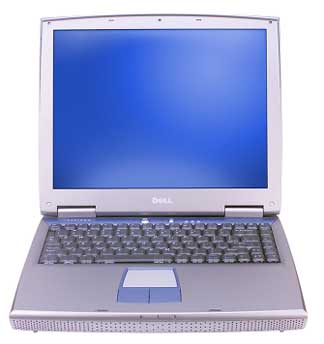Linux on the Dell Inspiron 1100See other Linux laptops at http://tuxmobil.orgChris Phillips
|
 |
Summary
A CD installation of Redhat 9 ran very smoothly with most devices auto-detected. I needed to download a few binary drivers for devices such as the network adapter. Power management is currently the only thing that I have noticed which is not supported.
Specifications
|
CPU
|
Intel® Celeron® 2192.928 MHz Cache 128 KB Bus 400 MHz |
|
Chipset
|
Intel 845GL |
|
Video
|
Intel Corp. 82845G/GL [Brookdale-G] Chipset Integrated Graphics Device (Intel® Extreme Graphics) Shared system memory Driver: i810 |
|
Ethernet
|
Broadcom 4401 100Base-T integrated controller Driver: bcm4400 |
|
Modem
|
Conexant D480 MDC V.92 softmodem Driver: hsfich hsfosspec hsfengine |
|
CD-ROM
|
Matshita 24x/10x/24x CD-RW/DVD-ROM, using ide-scsi
Device: /dev/scd0 |
|
Floppy Disk Drive
|
None (optional USB)
|
|
Hard Disk Drive
|
Fujitsu - 40 GB
Device: /dev/hdc |
|
USB
|
Intel Corp. 82801DB USB EHCI Controller
Driver: ehci-hcd usb-uhci |
|
PC Card
|
Texas Instruments PCI-1510 Cardbus controller
Supports one Type I or Type II card |
|
Audio
|
Sigmatel 9750 (Intel Corp. 82801DB AC'97 Audio)
Driver: i810_audio |
|
Memory
|
512MB (factory installed - using all SODIMM sockets full)
|
|
Display
|
Active-matrixTFT 14.1 inch - 1024×768 |
|
Ports
|
15 hole video Two USB2.0 compliant connectors RJ-11 modem connector RJ-45 Ethernet connector 7-pin mini-DIN S-video TV-out microphone & stereo headphone/speaker connectors NO serial, parallel or IR ports |
Installation
- The system came pre-installed with WinXP with an NTFS file system. I used PartitionMagic 7.01 to reduce the widows partition to 10 GB. The first 40MB partition is labelled "Dell Utility". I did not purchase the external USB floppy so I could not make a rescue disk. Apparently ntfsresize would have worked (but I don't have a boot floppy...). I probably should have created a partition of about 1 GB with a VFAT format, to share file between Linux and Windows
- Without a floppy, a cd install was the only option. I used RH9.0 which ran very smoothly.
- Video, audio, USB, PC Card, DVD/CD-burner were all auto-detected and run immediately without any troubles.
Update: If your notebook comes with the A22 BIOS or later, XFREE86 will not work. For a work around look at - The standard kernel does not include support for the Broadcom Ethernet adapter. But Broadcom does make a drive available which is easy to install (just make, make install) and it configured the network correctly - just remember to redo this when you update your kernel! Without a floppy disk, access to the NTFS file system or a working network connection it could be a little tricky getting the drivers onto the notebook. I used the USB key which I purchased from Dell with the notebook. The other option would be to burn a CD.
Update: Kernel 2.4.22 does include "experimental" support for the network adapter, but I haven't tested it yet.
- The softmodem is not supported in the standard kernel, but the fine folk at linuxant provide a driver, which works very well. Their scripts to detect which modem is installed did not work, but the HSF (softmodem) driver does the trick. I grabbed the i686 rpm for RH9 on their download page:
This installs the modem device as /dev/ttySHSF0. I created a symlink to /dev/modem and could create a modem entry in the Redhat network configurations gui. It could not find any modems, but I just told it /dev/modem and the PPP setup worked fine. If you update your kernel, run the included script hfsconfig.
Not working
- APM and ACPI are not supported by the 2.4 kernel. This means battery monitoring doesn't work nor does suspend (in fact it seems to crash the machine). Sean Horan has some instructions for getting ACPI running on 2.5.x series kernels.
Update: The 4.2.22 kernel comes with the most recent ACPI code. Applying the custom DSDT patch in a similar way to how Sean describes (and using the dsdt image he supplies), I have managed to get basic ACPI support working, including battery monitoring.
Not tested
- TV out
Miscellaneous
- The kernel presents USB mass storage devices (USB keys, digital cameras etc) as SCSI disks. On this system my USB key was loaded as /dev/sda1 and has a vfat filesystem. This can easily be mounted as
- mount /dev/sda1 /usb
or in your /etc/fstab
- /dev/sda1 /usb vfat noauto,user 0,0
- mount /dev/sda1 /usb
- In the installation process, I (incorrectly) selected a Logistic USB wheel mouse. The external USB mouse worked fine, but the internal trackpad did not. To get both working I needed to use the following in XF86Config. I would recommend reading:
- CD burning works OK with cdrecord. The -scanbus options only worked as root.
- DVD playback works with mplayer
- Mounting the WindowsXS filesystem readonly work OK with the kernel drivers available
from the Linux-NTFS Project
|
Identifier "Default Layout" Screen 0 "Screen0" 0 0 InputDevice "Mouse0" "CorePointer" InputDevice "USB Mouse" "AlwaysCore" InputDevice "Keyboard0" "CoreKeyboard" EndSection Section "InputDevice" Identifier "Mouse0" Driver "mouse" Option "Protocol" "PS/2" Option "Device" "/dev/psaux" Option "ZAxisMapping" "4 5" Option "Emulate3Buttons" "yes" EndSection Section "InputDevice" Identifier "USB Mouse" Driver "mouse" Option "Protocol" "IMPS/2" Option "Device" "/dev/input/mice" Option "ZAxisMapping" "4 5" Option "Emulate3Buttons" "yes" EndSection |
Configuration files
There have been a few request to see my configuration files. Here are a few you might find useful:
